Introducing a New Remote Sensing-Based Model for Forecasting Forest Fire Danger Conditions at a Four-Day Scale
Abstract
:1. Introduction
2. Study Area and Data Requirements
2.1. General Description of the Study Area
2.2. Data Requirements
3. Methods
3.1. Generation of Four-Day Composites for the RS-Based Input Variables
3.2. Forecasting of the Forest Fire Danger Conditions
3.3. Evaluation of the Final Danger Map
4. Results and Discussion
4.1. Quantitative Performance Assessment of the New Four-Day Scale RS-Based FFDFS Model
4.2. Case of the 2016 Horse River Wildfire
5. Conclusions
Author Contributions
Funding
Acknowledgments
Conflicts of Interest
References
- Natural Resources Canada. Wildland Fire Evacuations. Available online: http://www.nrcan.gc.ca/forests/climate-change/forest-change/17787 (accessed on 8 November 2017).
- Natural Resources Canada. Wildland Fire Management: Balancing the Bad and the Good. Available online: http://www.nrcan.gc.ca/forests/fire-insects-disturbances/fire/13143 (accessed on 23 July 2018).
- Regional Aquatics Monitoring Program (RAMP). The Distribution of Boreal Forests. Available online: http://www.ramp-alberta.org/river/boreal/distribution.aspx (accessed on 18 July 2019).
- Natural Resources Canada. Canadian National Fire Database. Available online: http://cwfis.cfs.nrcan.gc.ca/ha/nfdb (accessed on 18 July 2019).
- NRCan Natural Resources Canada. Facts about Wildland Fires in Canada. Available online: http://www.nrcan.gc.ca/forests/fire-insects-disturbances/fire/13143 (accessed on 23 July 2018).
- Wang, X.; Wotton, B.M.; Cantin, A.S.; Parisien, M.A.; Anderson, K.; Moore, B.; Flannigan, M.D. cffdrs: An R package for the Canadian Forest Fire Danger Rating System. Ecol. Process. 2017, 6. [Google Scholar] [CrossRef]
- Stocks, B.J.; Lawson, B.; Alexander, M.E.; Van Wagner, C.E.; McAlpine, R.S.; Lynham, T.J.; Dube, D.E. Canadian forest fire danger rating system: An overview. For. Chron. 1989, 65, 258–265. [Google Scholar] [CrossRef]
- Luke, R.H.; McArthur, A.G. Bushfires in Australia; Australian Government Publishing Service: Canberra, Australia, 1978; ISBN 9900020032504.
- Bradshaw, L.S.; Deeming, J.E.; Burgan, R.E.; Cohen, J.D. The 1978 National Fire-Danger Rating System; Department of Agriculture (Forest Service, Intermountain Forest and Range Experiment Station): Ogden, UT, USA, 1984.
- Natural Resources Canada. Canadian Wildland Fire Information System: Canadian Forest Fire Danger Rating System (CFFDRS). Available online: http://cwfis.cfs.nrcan.gc.ca/background/summary/fwi (accessed on 1 August 2018).
- Hély, C.; Flannigan, M.; Bergeron, Y.; McRae, D. Role of vegetation and weather on fire behavior in the Canadian mixedwood boreal forest using two fire behavior prediction systems. Can. J. For. Res. 2001, 31, 430–441. [Google Scholar] [CrossRef]
- Taylor, S.W.; Alexander, M.E. Science, technology, and human factors in fire danger rating: The Canadian experience. Int. J. Wildl. Fire 2006, 15, 121–135. [Google Scholar] [CrossRef]
- Forestry Canada Fire Danger Group. Development of the Canadian Forest Fire Behavior Prediction System; Forestry Canada, Science and Sustainable Development Directorate: Ottawa, ON, Canada, 1992.
- Natural Resources Canada. Canadian Wildland Fire Weather Index (FWI) System. Available online: http://cwfis.cfs.nrcan.gc.ca/background/summary/fwi (accessed on 1 August 2018).
- Natural Resources Canada. Canadian Forest Fire Behavior Prediction (FBP) System. Available online: http://cwfis.cfs.nrcan.gc.ca/background/summary/fbp (accessed on 1 August 2018).
- Chowdhury, E.H.; Hassan, Q.K. Development of a new daily-scale forest fire danger forecasting system using remote sensing data. Remote Sens. 2015, 7, 2431–2448. [Google Scholar] [CrossRef]
- Abdollahi, M.; Islam, T.; Gupta, A.; Hassan, Q. An Advanced Forest Fire Danger Forecasting System: Integration of Remote Sensing and Historical Sources of Ignition Data. Remote Sens. 2018, 10, 923. [Google Scholar] [CrossRef]
- Akther, M.S.; Hassan, Q.K. Remote sensing-based assessment of fire danger conditions over boreal forest. IEEE J. Sel. Top. Appl. Earth Obs. Remote Sens. 2011, 4, 992–999. [Google Scholar] [CrossRef]
- Chowdhury, E.H.; Hassan, Q.K. Operational perspective of remote sensing-based forest fire danger forecasting systems. ISPRS J. Photogramm. Remote Sens. 2015, 104, 224–236. [Google Scholar] [CrossRef]
- Babu, K.V.S.; Kabdulova, G.; Kabzhanova, G. Developing the Forest Fire Danger Index for the Country Kazakhstan by Using Geospatial Techniques. J. Environ. Inform. Lett. 2019, 1, 48–59. [Google Scholar] [CrossRef]
- Yu, B.; Chen, F.; Li, B.; Wang, L.; Wu, M. Fire Risk Prediction Using Remote Sensed Products: A Case of Cambodia. Photogramm. Eng. Remote Sens. 2017, 83, 19–25. [Google Scholar] [CrossRef]
- Chowdhury, E.H.; Hassan, Q.K. Use of remote sensing-derived variables in developing a forest fire danger forecasting system. Nat. Hazards 2013, 67, 321–334. [Google Scholar] [CrossRef] [Green Version]
- Li, X.; Lanorte, A.; Telesca, L.; Song, W.; Lasaponara, R. Assessment of MODIS-Based NDVI-Derived Index for Fire Susceptibility Estimation in Northern China Abstract. In Computational Science and Its Applications—ICCSA 2015; Gervasi, O., Murgante, B., Misra, S., Gavrilova, M.L., Rocha, A.M.A.C., Torre, C., Taniar, D., Apduhan, B.O., Eds.; Springer International Publishing AG Switzerland: Banff, AB, Canada, 2015; pp. 193–203. ISBN 78-3-319-21409-2. [Google Scholar]
- Bisquert, M.; Caselles, E.; Sánchez, J.M.; Caselles, V. Application of artificial neural networks and logistic regression to the prediction of forest fire danger in Galicia using MODIS data. Int. J. Wildl. Fire 2011, 21, 1025–1029. [Google Scholar] [CrossRef]
- Liu, W.; Wang, S.; Zhou, Y.; Wang, L.; Zhu, J.; Wang, F. Lightning-caused forest fire risk rating assessment based on case-based reasoning: A case study in DaXingAn Mountains of China. Nat. Hazards 2016, 81, 347–363. [Google Scholar] [CrossRef]
- Argañaraz, J.P.; Landi, M.A.; Bravo, S.J.; Gavier-Pizarro, G.I.; Scavuzzo, C.M.; Bellis, L.M. Estimation of Live Fuel Moisture Content from MODIS Images for Fire Danger Assessment in Southern Gran Chaco. IEEE J. Sel. Top. Appl. Earth Obs. Remote Sens. 2016, 9, 5339–5349. [Google Scholar] [CrossRef]
- MNP LLP. A Review of the 2016 Horse River Wildfire: Alberta Agriculture and Forestry Preparedness and Response; Forestry Division, Alberta Agriculture and Forestry: Edmonton, AB, Canada, 2017.
- Natural Regions Committee. Natural Regions and Subregions of Alberta; Government of Alberta: Edmonton, AB, Canada, 2006.
- Hassan, Q.K.; Bourque, C.P.A. Spatial enhancement of MODIS-based images of leaf area index: Application to the boreal forest region of northern Alberta, Canada. Remote Sens. 2010, 2, 278–289. [Google Scholar] [CrossRef]
- Roy, D.P.; Frost, P.G.H.; Justice, C.O.; Landmann, T.; Le Roux, J.L.; Gumbo, K.; Makungwa, S.; Dunham, K.; Du Toit, R.; Mhwandagara, K.; et al. The Southern Africa Fire Network (SAFNet) regional burned-area product-validation protocol. Int. J. Remote Sens. 2007, 26, 4265–4292. [Google Scholar] [CrossRef]
- Morisette, J.T.; Baret, F.; Liang, S. Special issue on global land product validation. IEEE Trans. Geosci. Remote Sens. 2006, 44, 1695–1696. [Google Scholar] [CrossRef]
- Olofsson, P.; Foody, G.M.; Herold, M.; Stehman, S.V.; Woodcock, C.E.; Wulder, M.A. Good practices for estimating area and assessing accuracy of land change. Remote Sens. Environ. 2014, 148, 42–57. [Google Scholar] [CrossRef]
- Fornacca, D.; Ren, G.; Xiao, W. Performance of Three MODIS Fire Products (MCD45A1, MCD64A1, MCD14ML), and ESA Fire_CCI in a Mountainous Area of Northwest Yunnan, China, Characterized by Frequent Small Fires. Remote Sens. 2017, 9, 1131. [Google Scholar] [CrossRef]
- EARTHDATA. FIRMS FAQ. Available online: https://earthdata.nasa.gov/faq/firms-faq (accessed on 21 June 2019).
- Adab, H.; Kanniah, K.D.; Solaimani, K. Modeling forest fire risk in the northeast of Iran using remote sensing and GIS techniques. Nat. Hazards 2013, 65, 1723–1743. [Google Scholar] [CrossRef]
- Abdollahi, M.; Dewan, A.; Hassan, Q. Applicability of Remote Sensing-Based Vegetation Water Content in Modeling Lightning-Caused Forest Fire Occurrences. ISPRS Int. J. Geo-Inf. 2019, 8, 143. [Google Scholar] [CrossRef]
- De Angelis, A.; Bajocco, S.; Ricotta, C. Phenological variability drives the distribution of wildfires in Sardinia. Landsc. Ecol. 2012, 27, 1535–1545. [Google Scholar] [CrossRef]
- Jolly, W.M.; Hintz, J.; Kropp, R.C.; Conrad, E.T. Physiological drivers of the live foliar moisture content ‘spring dip’ in Pinus resinosa and Pinus banksiana and their relationship to foliar flammability. In Proceedings of the VII International Conference on Forest Fire Research, Coimbra, Portugal, 17–20 November 2014. [Google Scholar]
- Pickell, P.D.; Coops, N.C.; Ferster, C.J.; Bater, C.W.; Blouin, K.D.; Flannigan, M.D.; Zhang, J. An early warning system to forecast the close of the spring burning window from satellite-observed greenness. Sci. Rep. 2017, 7, 1–10. [Google Scholar] [CrossRef]
- McIntyre, J. Moving forward: The Economic Impact of Rebuilding the Wood Buffalo Region’s Economy; The Conference Board of Canada: Ottawa, ON, Canada, 2017. [Google Scholar]
- Ahmed, M.R.; Rahaman, K.R.; Hassan, Q.K. Remote Sensing of Wildland Fire-Induced Risk Assessment at the Community Level. Sensors 2018, 18, 1570. [Google Scholar] [CrossRef]
- KPMG. May 2016 Wood Buffalo Wildfire: Post-Incident Assessment Report; Alberta Emergency Management Agency: Edmonton, AB, Canada, 2017.
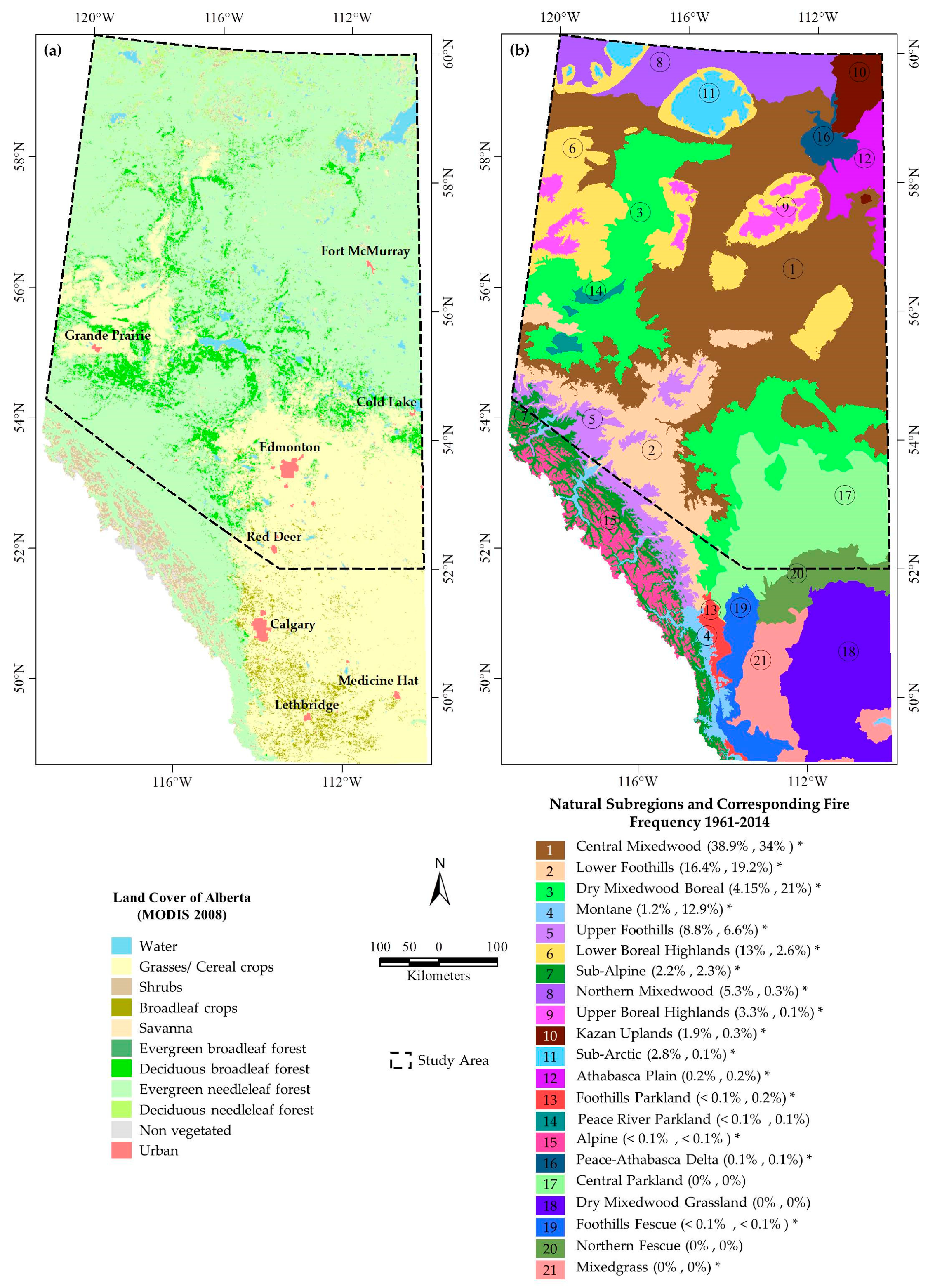
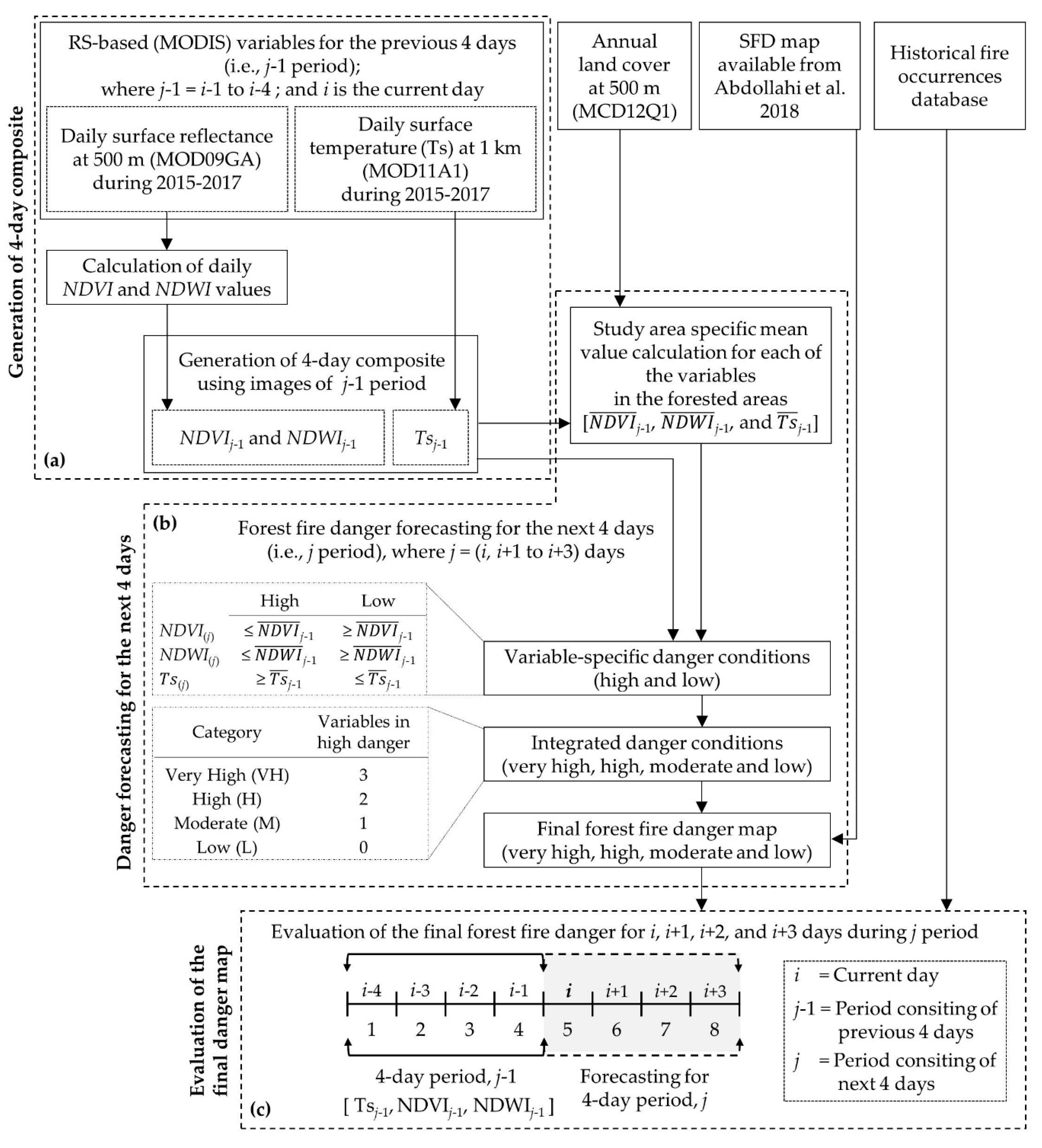
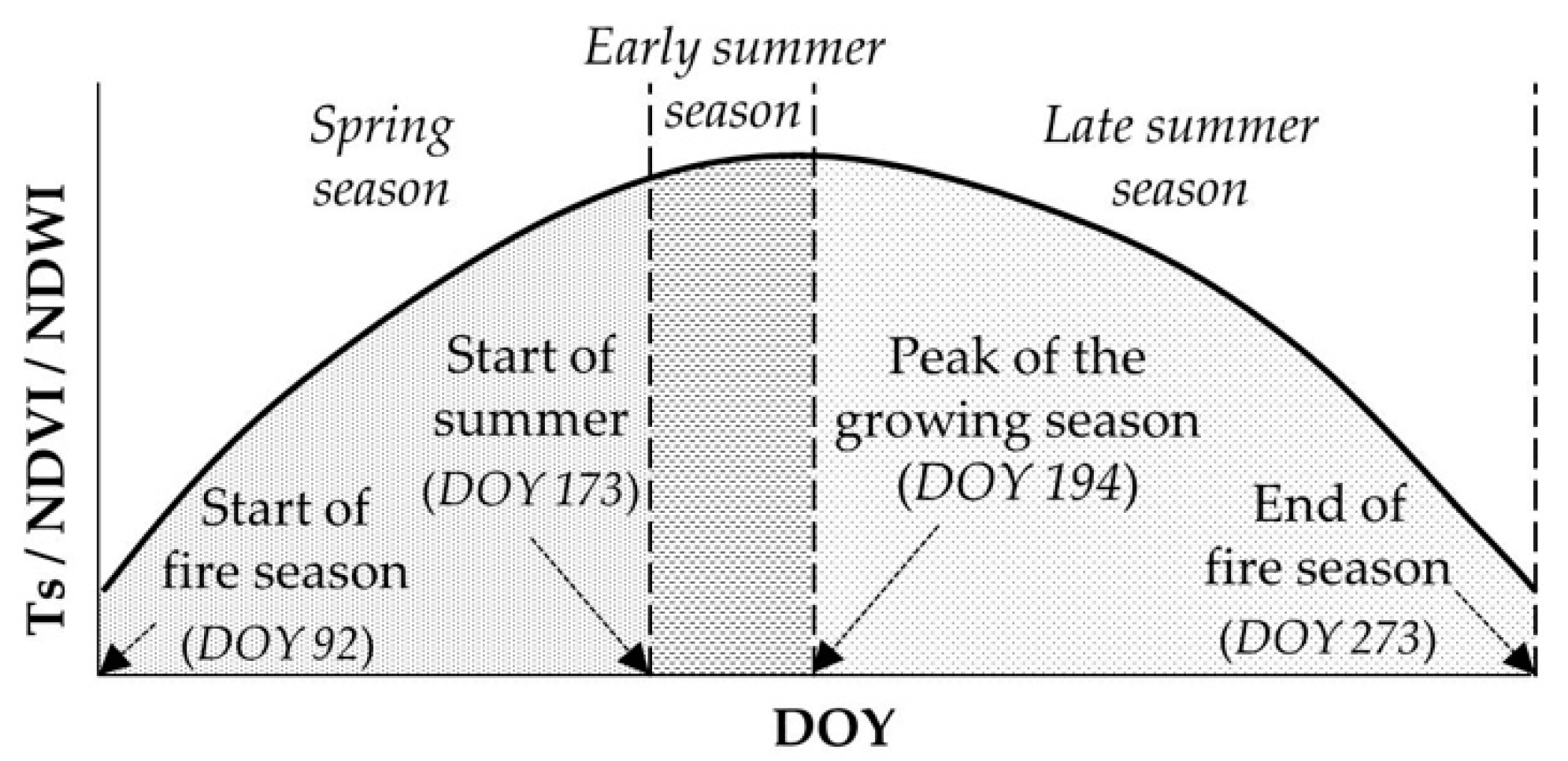

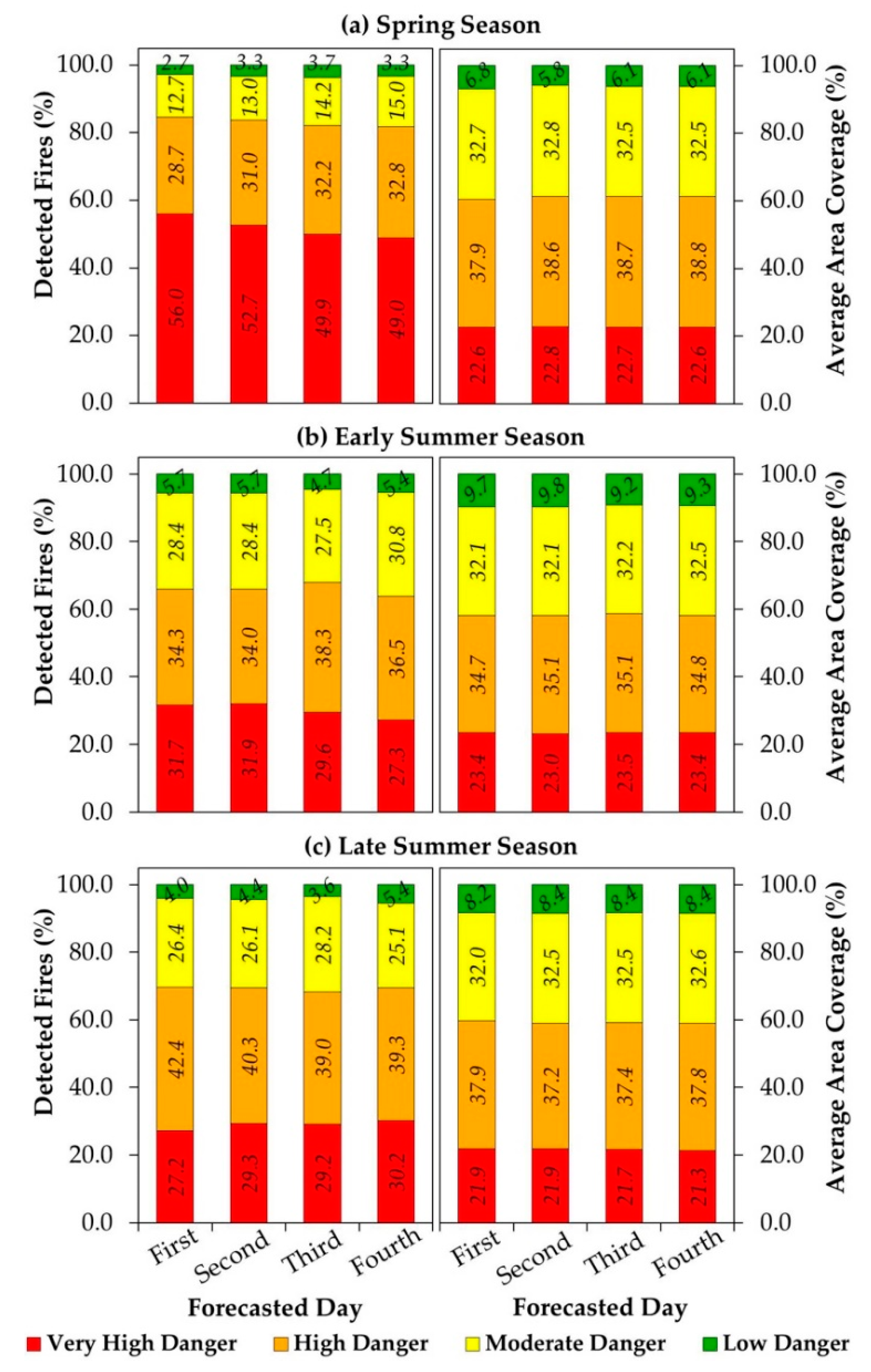
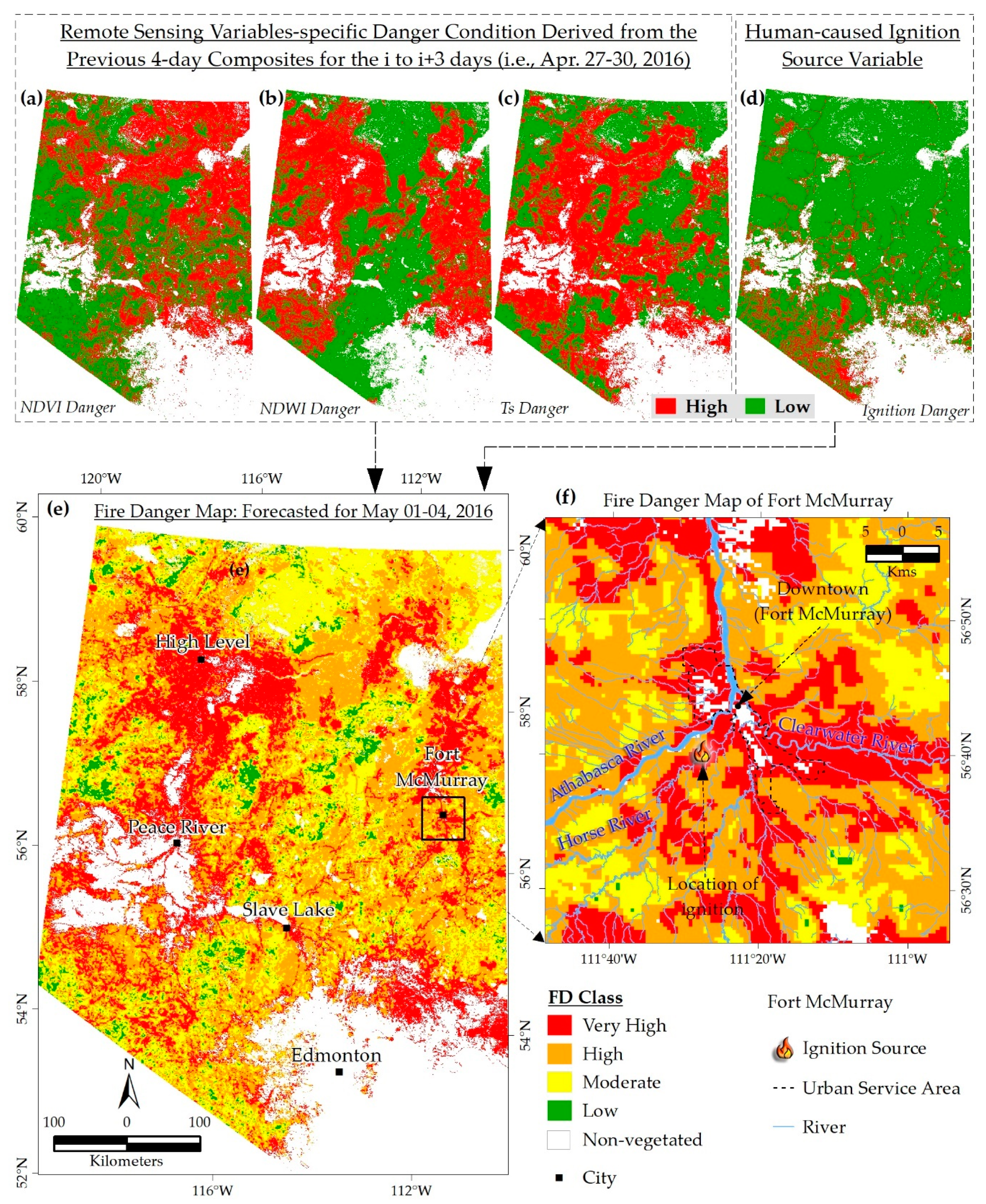
| Data | Source | Period | Description | Scope of Use |
|---|---|---|---|---|
| Moderate resolution imaging spectro-radiometer (MODIS) | National aeronautics and space administration (NASA) | 2015–2017 (30 Mar to 29 Sept each year) | MODIS/Terra Surface Reflectance Daily L2G Global imagery (i.e., MOD09GA v006) at 500 m spatial resolution. | Employed to calculate NDVI and NDWI; and generating their four-day composites over our study area. |
| MODIS/Terra Land Surface Temperature/Emissivity Daily L3 Global 1 imagery (i.e., MOD11A1 v006) at 1 km spatial resolution. | Utilized to generate four-day composites at 500m spatial resolution for the study area. | |||
| 2008 | Land cover of MODIS/Terra+Aqua Type Yearly L3 Global (i.e., MCD12Q1) at 500 m spatial resolution. | Used to identify the intended forest vegetation types in our study area that includes: (i) evergreen broadleaf, (ii) deciduous broadleaf, (iii) evergreen needleleaf, and (iv) deciduous needleleaf | ||
| Ground-based | Alberta Forest Service, Govt. of Alberta | 1961–2017 | A spatial database with the locations of historical fire occurrence. | Employed as a validation dataset for evaluating the FD maps. |
| Vector layers | 2006 | Geographical boundary of Alberta | Used in generating the FD maps. | |
| 2000 | Road network of Alberta |
| Input Variable | Danger Condition, j | Assumptions | |
|---|---|---|---|
| High | Low | ||
| Tsj | ≥ Tsj-1 | < Tsj-1 | Higher than average temperatures of the surrounding landscape may favor forest fire occurrence |
| NDVIj | ≤ NDVIj-1 | > NDVIj-1 | Low greenness in compare to the surrounding landscape may support initiating forest fire |
| NDWIj | ≤ NDWIj-1 | > NDWIj-1 | Low moisture content in vegetation may support fire |
| Category | Number of Variable in the High Danger Class |
|---|---|
| Very High (VH) | All three variables |
| High (H) | At least two variables |
| Moderate (M) | At least one variable |
| Low (L) | None of the variables |
| Integrated FD Map (Three Variables) | Ignition Source-Based SFD Map | Final FD Map (Four Variables) |
|---|---|---|
| Very High | High | Very High |
| High | Very High | |
| Moderate | High | |
| Low | Moderate | |
| Very High | Low | Very High |
| High | High | |
| Moderate | Moderate | |
| Low | Low |
© 2019 by the authors. Licensee MDPI, Basel, Switzerland. This article is an open access article distributed under the terms and conditions of the Creative Commons Attribution (CC BY) license (http://creativecommons.org/licenses/by/4.0/).
Share and Cite
Ahmed, M.R.; Hassan, Q.K.; Abdollahi, M.; Gupta, A. Introducing a New Remote Sensing-Based Model for Forecasting Forest Fire Danger Conditions at a Four-Day Scale. Remote Sens. 2019, 11, 2101. https://doi.org/10.3390/rs11182101
Ahmed MR, Hassan QK, Abdollahi M, Gupta A. Introducing a New Remote Sensing-Based Model for Forecasting Forest Fire Danger Conditions at a Four-Day Scale. Remote Sensing. 2019; 11(18):2101. https://doi.org/10.3390/rs11182101
Chicago/Turabian StyleAhmed, M. Razu, Quazi K. Hassan, Masoud Abdollahi, and Anil Gupta. 2019. "Introducing a New Remote Sensing-Based Model for Forecasting Forest Fire Danger Conditions at a Four-Day Scale" Remote Sensing 11, no. 18: 2101. https://doi.org/10.3390/rs11182101
APA StyleAhmed, M. R., Hassan, Q. K., Abdollahi, M., & Gupta, A. (2019). Introducing a New Remote Sensing-Based Model for Forecasting Forest Fire Danger Conditions at a Four-Day Scale. Remote Sensing, 11(18), 2101. https://doi.org/10.3390/rs11182101






